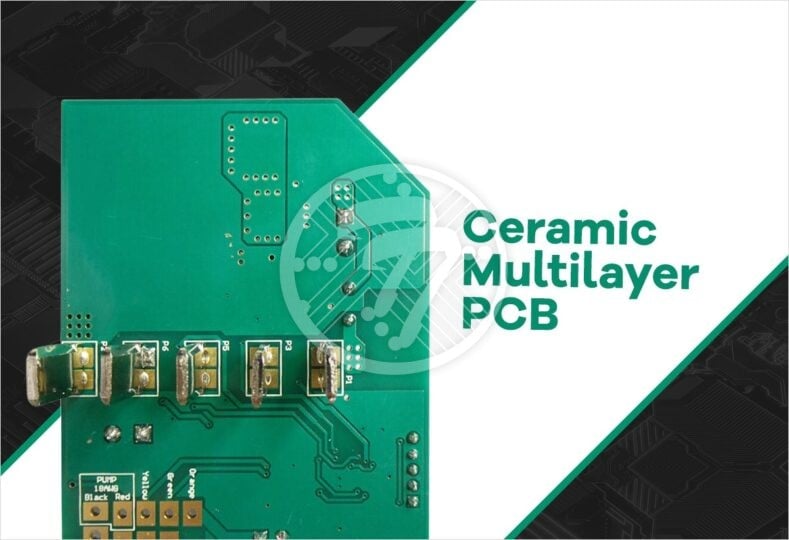Ceramic Multilayer PCB – Top Advantages and Disadvantages!

The success of a PCB has a lot to do with the selection of the board material. While FR4 is often used as a default option, the fact remains that there are a number of alternatives that offer better performance and maybe lower costs. Let us look at some of the advantages and disadvantages of a relatively modern technology – ceramic multilayer PCB – that is increasingly gaining ground.
Ceramic Multilayer PCBs
With miniaturization of devices becoming the norm, the PCB industry has been focusing on miniaturization of traditional substrate and laminate PCB materials as well as increased layers. However there have always been challenges around issues such as:
- Heat dissipation
- Removal of excesses from the board, and more.
The above has necessitated the search for materials that would work well given the challenges. In many ways ceramic PCBs have been a strong answer. Ceramic materials such as aluminum oxide, aluminum nitride, beryllium oxide and more are seen to perform well on parameters such as:
- Thermal conductivity
- Resistance to erosion
- CTE component compatibility
- High density trace routing, and more
Advantages of Ceramic Printed Circuit Boards
Before we look at the advantages of ceramic boards in detail, it is important to mention that ceramic isn’t a single material but a class of materials with similar physical and chemical properties.
Thermal Conductivity
A big advantage with ceramic material is its high thermal conductivity. In fact, as compare to ceramic, FR4 has extremely low thermal conductivity. Some figures will put this in perspective:
- Aluminum Oxide is 20 times as thermally conductive as FR4.
- Aluminum Nitride and Silicon Carbide are about 100 times as thermally conductive as FR4.
- Boron Nitride is known to have the highest thermal conductivity.
In case of FR4 PCBs the low thermal conductivity is compensated by using elements such as:
- Thermal Vias
- Metal Planes
- Fans
- Thermal Landings, and more to direct heat away from the surface layers.
Ceramic boards, on account of their high thermal conductivity, usually do not require these elements as heat can easily be transported to a thermal landing or an active cooling element.
Additionally, the high thermal conductivity ensures that there isn’t any formation of hot spots in the surface as well as the inner circuit layers as heat transport is uniform.
Low Electrical Conductivity
Despite being high on thermal conductivity, the electrical conductivity of ceramics is still low enough for it to be used for PCB substrates. Additionally, it is also possible to adjust the electrical conductivity of ceramic boards through doping.
Do not exert stress on vias
Another advantage of using ceramic boards is that they do not tend to exert a large amount of stress on any vias leading to their fracture. Vias in FR4 boards, particularly are susceptible to fracture during thermal cycling. The risk of fracture is on account of the fact that there are mismatches in the thermal expansion coefficient of copper and FR4. Thermal cycling of the boards, therefore, creates stress along the via barrel and is prone to fractures. In the case of ceramic circuit boards, their thermal expansion coefficients are closer to the values for their conductor structures. This reduces stress during thermal cycling. Also, with the thermal expansion being uniform the stress son any via is significantly reduced.
Mechanical Strength
The big advantage with ceramics is also its mechanical strength. Its ability to withstand high mechanical load as well as strong vibrations and shock can go a long way in their use in harsh operating environments. This is made possible because a ceramic board has a lower Young’s Modulus as opposed to FR4. The ceramic board, therefore, tends to deform much less as opposed to an FR4 board when the same pressure is applied.
Some of the other pros of using ceramic boards include:
- They resist chemical erosion.
- Have compatible mechanical intensity.
- Easy high-density tracing implementation.
This does not, however, mean that ceramic boards come with any disadvantages. The main disadvantages associated with ceramic boards include:
- They have a higher cost than standard PCBs.
- They aren’t as widely available.
- They entail careful handling.
It is important, therefore, to go over the features required by you carefully, in making the right choice of printed circuit boards.
At Technotronix, our highly qualified and experienced multilayer PCB manufacturer ensures that all the layers are correctly registered. Adhering to high-quality multilayer PCB manufacturing practices, we are equipped to handle complex boards with up to 24 layers, which are laminated to insulate them. If you are looking for progressive ceramic multilayer PCBs, you are at the right place.
In case if you have any questions, please feel free to contact us via email at [email protected] or call us on 714/630-9200.






